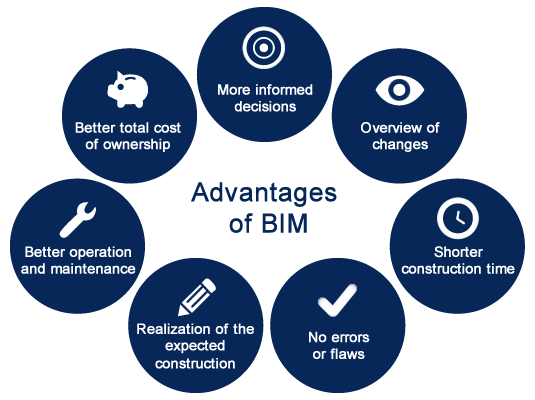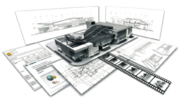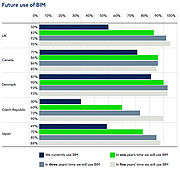BIM as a Management Tool in Construction Projects
RikkeWitten (Talk | contribs) (→Use and Benefits) |
RikkeWitten (Talk | contribs) (→Use and Benefits) |
||
| Line 94: | Line 94: | ||
=== Quality === | === Quality === | ||
| − | As the | + | As the information in the project is automatically shared, the model is automatically updated in all linked models and the most fatal clashes of installations can be solved prior to physically starting the construction, the resulting construction/building will be of much higher quality. |
=== Time === | === Time === | ||
Revision as of 00:04, 17 September 2016
As the Architecture, Engineering and Construction (AEC) industry evolves, the demand for more complex and unique constructions increases, and the risk for failure increases with it. The Project Manager, in the field of construction, is faced with great deals of uncertainties, high complexity and high risks of failure. In order to carry out a successful project, it is advantageous to make the project more transparent, optimize the process and the communication between the active stakeholders of the project. With the increase of digital documentation in construction, the aspect of Information and Communication Technology (ICT) is of great importance, and within construction, Building Information Modelling (BIM) has become an effective tool for the Project Manager to reach the desired goals of a project within the given constraints.
“A model can represent all three dimensions of a composition directly, while a drawing can represent only two unambiguously. Thus it takes two drawings to represent the information provided by a single model.” - Charles M. Eastman[1]
Contents |
Definition of BIM
BIM (Modelling) is a digital management tool/process, containing BIMs (Models). The concept of BIM is to create an intelligent platform for sharing data and construct the building virtually, before starting the physical construction. [2]
The models used in BIM are parametric object based, meaning that each object contains data about how it can interact with connected objects. The object can also contain designparametres, altering the visualization of the object according to the imput and the changes to an object are able to automatically change in all views.
The management possibilities of using BIM has developed from simple visualization into a multi functional tool, depending on the chosen dimension of modelling:
- 3D - Visualization
- The project is modelled in 3D and components contain detailed data for extraction of bills of quantity with limited product information.
- 4D - Scheduling
- The 3D model is combined with a time schedule, making it possible to simulate and manage the time aspect of the project, with the information stored in the model.
- 5D - Estimating (current development)
- The cost aspect is added to the 4D model. The bills of quantity are connected to catalouges from the suppliers and the cost estimation is automatically calculated.
- 6D - Sustainability (developing)
- An environmental aspect is added to the 5D model, making it possible to automatically generate lighting and energy consumation analysis. As the model at the current state of development already contains most of the informations needed for these analysis, and seperate semi-manual software for making these analysis already exists (e.g. Dialux for lighting and Be10 for energy consumption), the use of 6D BIM might not be too far in the future.
- 7D - Facility Management Applications (future development)
- After the construction phase has ended, and the building is finished, the detailed and information packed models can be used for facility management, as the Facility Manager then has the detailed information (such as price, supplier, material etc.) about every component in the building all stored in one model.
Historical development
The 2D construction drawing has been used for centuries and for complex constructions, physical models have been used to get a better understanding of the physical spaces of the construction.
BIM, as we know it today, has been 40 years in the making and already in 1975, Charles M. Eastman mentioned in an article from 1975[1] several disadvantages of both 2D drawings and the physical 3D models and described the ideal vision for a digital, multidisciplinary 3D model with the possibility of extraction of 2D drawings, lists of quantity for cost estimation and automatized clash-testing. Furthermore Eastman explained how the models should be based on components containing non-redundant data, meaning that a change in one view, would propagate to the rest of the views.
The “Building Description System (BDS)” approach, described by Charles M. Eastman[1], was further developed during the 70s and 80s and was in the USA referred to as “Building Product Models” and in Europe as “Product Information Models”. These two terms were later combined to the term "Building Information Modelling (BIM)" as we know it today and was first documented in 1992 by van Nederveen and Tolman from TU Delft in the Netherlands.[3]
Due to the limited development of the personal computer and the fact, that the construction industry has a reputation for being very slow/reluctent to adopt change [4], the use of BIM did not take, until in the
The use of BIM has expanded during the last decade and in 2016, according to the NBS [5], 81% of the respondents in Denmark was using BIM.
Application
Building Information Modelling (BIM) can be applied to any size of construction project as a tool or process of managing the fundamental areas in Project Management and some of the application areas, listed by Marketing Analytic, Rachel Burger [6], is following:
- 3D visualization of buildings
- A 3D models have been used for visualization of project for a long time, which is why many users and developers often stop at this application of BIM.[6] However, the Building Information Models are so much more than a vizualisation tool.
- Change management (clash tests, revisions)
- By using a shared server (e.g. Revit Sever) a central model can be created, for all the discipline models to be linked into. By linking the models together, changes in one model, are automatically changed in all views (in contrary to the 2D way of working, where e.g. new architectural drawings would have to be manually imported to all electrical-, ventillation-, water- and plumbing drawings as xreferences, leaving many steps for failure).
- The 3D models from the architects and all the engineering disciplines can be tested for clashes between the models.
- Construction simulation (4D)
- The time estimation can be visualized with adding the time-aspect to the 3D model
- The 3D model can be combined with a time schedule of the project in order to simulate the construction from start to finish.
- Data management (quantity and cost estimation)
- The BIMs of today, can contain large amount of information, that are automatically shared along with the model itself.
- Bills of quantities can be automatically created from the information, stored in each object in the model (e.g. windows, doors, lighting fixtures etc.)
- Operational management
Use and Benefits
The measured percentage benefits from using BIM in construction projects are based on data from 32 major projects, gathered by Stanford University’s Center for Integrated Facilities Engineering (SUCIFE).[7] The benefits of BIM as an ICT-tool in construction are closely related to the actual use of the model. BIM has the possibility to be an effective tool for managing multiple challenges in construction projects.

Communication
As a construction projects are highly dependent on coordination of multiple fields of construction and therefore multiple people from different organizations. [8] By using BIM the project can be made more "transparent"
In large, multistorage constructions, different tasks can be carried out by different constractors (carpentry, painting, electrical etc.) simultaniously, which can cause conflicts and unecessary waiting
Risk
In every project, the Project Manager is faced with uncertainties and risks, wherefore it is important to be able to act and react to unexpected events, exploit possibilities and plan for the unknown. In construction, the most common uncertainties and risks are time and economy overrun due to failure in communication, changes in the work/design, complications on site etc. [9] By using BIM as a management tool, some of these risks can be reduced by planning for the unknown and simulating multiple outcomes.
Stakeholder
The stakeholders of a construction project span from the professionals in the decision making and design phase, such as engineers, users, neighbours, investors etc. The 3D visualization part of BIM can be used to manage stakeholders expectations as it gives a more relatable visual of the product, in comparison to the 2D drawings.
Cost
Since the models in BIM contain information about all the components in the building, detailed lists of quantity can be extracted and the study from SUCIFE found that the cost estimation accuracy was within 3% as compared to traditional estimates[7], where the a cost estimation was made separately for each discipline and multiplied with a safety factor, causing the final estimate to be unnecessarily far on the safe side.
During the construction phase, research has shown how up to 40% of unbudgeted changes had been eliminated by using BIM in the design phase and how through clash detections would result in savings of up to 10% of the contract value.[7]
Quality
As the information in the project is automatically shared, the model is automatically updated in all linked models and the most fatal clashes of installations can be solved prior to physically starting the construction, the resulting construction/building will be of much higher quality.
Time
With the use of a 4D Building Information Model, the time can be managed through simulated construction. A simulation can reveal time conflicts early in the design phase, which can then be solved before they become a delay. By preventing delays and being able to pre-plan for conflicts, the research from SUCIFE showed up to 7% reduction in project duration in the 32 projects.[7]
Also the duration of the design phase has potential to be reduced, as the research has found that the use of BIM resulted in up to 80% reduction in time taken to generate a cost estimate.[7]
Tools
When using BIM, it is important to use the right software for the extended desire of use, and to ensure, that the different chosen software are compatible.
The following list some of the more popular software for each use of BIM:
- 3D Model
- - Autodesk Revit
- - Archicad
- - Graphisoft
- Clash Test
- - Navisworks
- - Solibri
- 4D model (3D + time)
- Time schedule
- - MS Project
- Simulation
- - Navisworks
Limitations
As mentioned previously, BIM can be applied advantageously in any size of construction project, however, at the current state of BIM adoption, the economical cost/benefit is more obvious in the larger, more complex construction projects. As BIM requires 3D modelling done for all engineering fields (e.g. water, plumbing, ventilation, construction and electrical) in order to gain the most value in terms of clash-testing, the modelling skills of the individual pereson and the cost of the 3D modelling software, can be limitating for smaller projects and companies. It is possible for companies to purchase project specific modelling assistance, however, the decision to spend the extra money, highly depends on the size and complexity of the project in question.
Conclusion
Annotated Bibliography
For further reading about BIM,
Books
Articles
Websites
References
- ↑ 1.0 1.1 1.2 Charles M. Eastman, The Use of Computers Instead of Drawings In Building Design, AIA Journal, March 1975
- ↑ Deke Smith, An Introduction to Building Information Modeling (BIM), Journal of Building Information Modeling, Fall 2007
- ↑ http://codebim.com/resources/history-of-building-information-modelling/
- ↑ http://www.bimpanzee.com/about-building-information-modeling--bim-.html/
- ↑ http://www.bauen-digital.ch/assets/Medienmitteilung/1603-NBS-International-BIM-Report.pdf%7C/
- ↑ 6.0 6.1 http://blog.capterra.com/the-top-6-free-bim-software-tools/
- ↑ 7.0 7.1 7.2 7.3 7.4 http://ascelibrary.org/doi/10.1061/%28ASCE%29LM.1943-5630.0000127
- ↑ Joana Geraldi, Christian Thuesen and Josef Oehmen, How To DO Projects, Version 0.5, 27. July 2016
- ↑ http://www.designingbuildings.co.uk/wiki/Risk_in_building_design_and_construction



